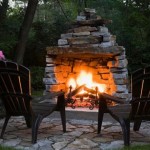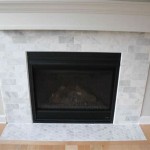Enhancing Your Home with Stone Tiles Fireplace Surrounds
A fireplace serves as a focal point in many homes, offering warmth, ambiance, and aesthetic appeal. The surround, the area directly encircling the firebox, plays a crucial role in defining the fireplace's overall style. Stone tiles have emerged as a popular choice for fireplace surrounds due to their durability, natural beauty, and versatility in design. This article explores the benefits, considerations, and installation aspects of stone tile fireplace surrounds, providing a comprehensive overview for homeowners considering this upgrade.
Stone tiles encompass a wide range of natural materials, each possessing unique characteristics. Options include granite, marble, slate, travertine, and limestone. Each type of stone offers distinct color variations, veining patterns, and textures, allowing homeowners to select a material that complements their existing décor and personal preferences. The choice of stone also influences the overall cost and maintenance requirements of the fireplace surround.
Durability and Heat Resistance
One of the primary advantages of using stone tiles for a fireplace surround is their inherent durability and resistance to heat. Fireplaces generate significant heat, and the surround must be able to withstand these temperatures without cracking, warping, or discoloring. Stone, particularly granite and slate, demonstrates excellent heat resistance, making it a suitable material for this application. Unlike wood or painted surfaces, stone tiles will not readily combust or emit harmful fumes when exposed to high temperatures.
The inherent density of stone contributes to its durability. It can withstand everyday wear and tear, resisting scratches, dents, and impacts. This is particularly beneficial in high-traffic areas or homes with children and pets where the fireplace surround is more likely to experience accidental contact. With proper care and maintenance, a stone tile fireplace surround can last for decades, providing lasting beauty and functionality.
Furthermore, the non-porous nature of some stone types, such as granite, makes them resistant to staining. This characteristic is particularly valuable in a fireplace surround, as it is likely to be exposed to soot, ash, and spills. A simple wipe-down is often sufficient to remove these stains, maintaining the aesthetic appeal of the stone.
However, it's crucial to note that while most natural stones are highly heat resistant, certain types, particularly those with high moisture content or inherent weaknesses, might be more susceptible to thermal shock. Thermal shock occurs when a material experiences a rapid change in temperature, causing it to crack or fracture. It's essential to consult with a stone supplier or installer to ensure the chosen stone is appropriate for fireplace applications.
Aesthetic Versatility and Design Options
Stone tiles offer unparalleled aesthetic versatility, allowing homeowners to create a fireplace surround that perfectly reflects their individual style. The natural variations in color, veining, and texture within each stone type create a unique and visually appealing surface. From the sleek, modern look of polished granite to the rustic charm of tumbled travertine, there is a stone tile to suit virtually any design aesthetic.
The size and shape of the tiles also contribute to the overall design. Large format tiles can create a seamless and contemporary appearance, while smaller mosaic tiles can add intricate detail and visual interest. The tiles can be arranged in various patterns, such as a classic stacked bond, a herringbone pattern, or a more intricate custom design. The grout color also plays a significant role in the final look. A contrasting grout color can highlight the individual tiles, while a matching grout color can create a more unified appearance.
Furthermore, stone tiles can be combined with other materials to create a more dynamic and personalized fireplace surround. For instance, a stone tile surround can be accented with a wooden mantel, a metal insert, or decorative stone accents. The possibilities are virtually endless, allowing homeowners to create a truly unique and eye-catching focal point.
The natural texture of stone adds another layer of visual interest. Some stones, like slate, have a naturally clefted surface, providing a rustic and tactile feel. Others, like marble, can be polished to a high sheen, creating a smooth and luxurious appearance. The choice of texture depends on the desired aesthetic and the overall design of the room.
Beyond the tiles themselves, the overall design of the fireplace surround can significantly impact the room's aesthetic. Simple, minimalist designs can create a clean and modern look, while more elaborate designs with intricate moldings and details can evoke a sense of grandeur and tradition. The overall size and proportions of the surround should be carefully considered to ensure it complements the scale of the room.
Installation and Maintenance Considerations
The installation of a stone tile fireplace surround requires careful planning and execution to ensure a safe, durable, and aesthetically pleasing result. It's crucial to properly prepare the surface before installing the tiles. This typically involves cleaning the existing surface, ensuring it is level and structurally sound, and applying a suitable bonding agent.
Cutting stone tiles requires specialized tools and techniques. Depending on the type of stone, a wet saw with a diamond blade is typically used to ensure clean and accurate cuts. It's essential to wear appropriate safety gear, including eye protection and respiratory protection, when cutting stone tiles.
The tiles are typically adhered to the surface using a thin-set mortar specifically designed for stone applications. The mortar should be applied evenly and the tiles should be carefully positioned to ensure proper alignment and spacing. Grout is then applied to fill the spaces between the tiles, providing a water-resistant seal and enhancing the overall appearance.
The choice of grout is also important. Epoxy grout is more durable and stain-resistant than cement-based grout, making it a good choice for high-traffic areas or areas prone to spills. However, epoxy grout can be more difficult to work with and may require professional installation.
Once the installation is complete, proper sealing is often necessary to protect the stone from staining and moisture damage. The type of sealant required will depend on the type of stone. Some stones, like granite, are naturally less porous and may require less frequent sealing than others, like travertine.
Regular maintenance is essential to keep a stone tile fireplace surround looking its best. This typically involves cleaning the surface with a mild detergent and water. Avoid using harsh chemicals or abrasive cleaners, as these can damage the stone's surface. Periodic resealing may also be required to maintain the stone's protective barrier.
It's important to note that natural stone is subject to variations in color and texture. These variations are part of the stone's natural beauty and should be embraced rather than viewed as defects. However, it's a good idea to purchase extra tiles during the initial installation to ensure a consistent color and texture throughout the surround. These extra tiles can also be used for future repairs or replacements.
For complex installations or homeowners who are not comfortable working with stone tiles, it is advisable to hire a professional installer. A qualified installer will have the necessary skills, tools, and experience to ensure a successful and long-lasting installation. They can also provide valuable advice on stone selection, grout choices, and maintenance procedures.
When selecting a stone tile fireplace surround, it's important to consider the overall design of the room, the budget, and the maintenance requirements. By carefully considering these factors, homeowners can choose a stone that will provide lasting beauty, durability, and value to their home.
Before undertaking any fireplace surround project, it's essential to consult with local building codes and regulations to ensure compliance. Some jurisdictions may have specific requirements for fireplace surrounds, such as minimum clearances from combustible materials. Failing to comply with these regulations can result in fines or require costly rework.
In conclusion, stone tiles offer a versatile and durable option for fireplace surrounds, providing a wide range of design possibilities and long-lasting beauty. By carefully considering the factors discussed in this article, homeowners can make informed decisions and create a fireplace surround that enhances the aesthetic appeal and value of their home.

Easy L And Stick Stone Fireplace Surround Sondra Lyn At Home

Fireplace Tile Ideas For Homeowners Ready A Redesign

Tile Fireplaces Coco

To Paint Or Not Stone Tile Fireplace More

Most Popular Fireplace Tiles Ideas This Year You Need To Know Best Design Globe Light Home Remodel Rustic Farmhouse

Fireplace Tiles Classique Floors Tile Portland Or

Is A Cozy Stacked Stone Fireplace Your Next Dream Project

Rustic Tile Fireplace Tiled Wall White Stone Fireplaces Surround

To Paint Or Not Stone Tile Fireplace More

Fireplace Tiles Stone Porcelain More The Tile
Related Posts








